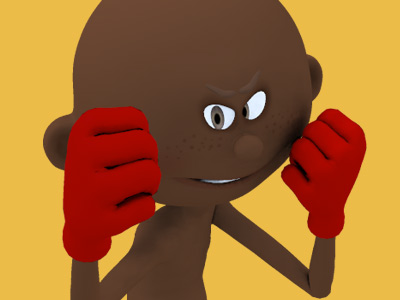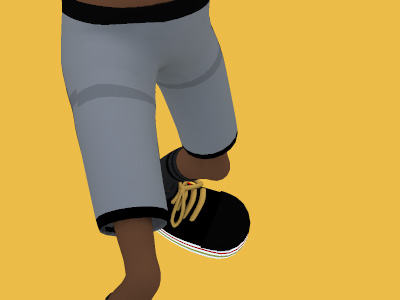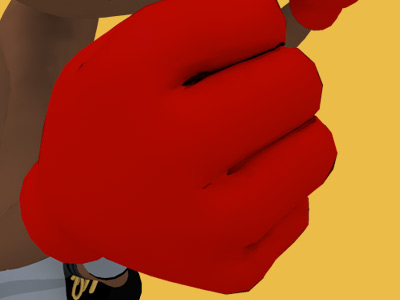Boxing
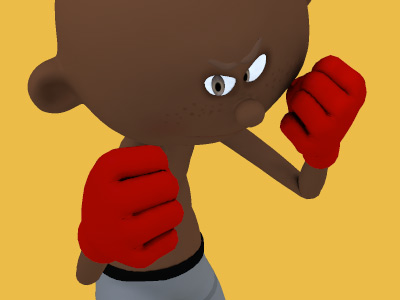
Boxing Styles
"Style" is often defined as the strategic approach a fighter takes during a bout. No two fighters' styles are alike, as it is determined by that individual's physical and mental attributes. Three main styles exist in boxing: outside fighter ("boxer"), brawler (or "slugger"), and Inside fighter ("swarmer"). These styles may be divided into several special subgroups, such as counter puncher, etc. The main philosophy of the styles is, that each style has an advantage over one, but disadvantage over the other one. It follows the rock-paper-scissors scenario - boxer beats brawler, brawler beats swarmer, and swarmer beats boxer.
Boxer/out-fighter
A classic "boxer" or stylist (also known as an "out-fighter") seeks to maintain distance between himself and his opponent, fighting with faster, longer range punches, most notably the jab, and gradually wearing his opponent down. Due to this reliance on weaker punches, out-fighters tend to win by point decisions rather than by knockout, though some out-fighters have notable knockout records. They are often regarded as the best boxing strategists due to their ability to control the pace of the fight and lead their opponent, methodically wearing him down and exhibiting more skill and finesse than a brawler. Out-fighters need reach, hand speed, reflexes, and footwork.
Boxer-puncher
A boxer-puncher is a well-rounded boxer who is able to fight at close range with a combination of technique and power, often with the ability to knock opponents out with a combination and in some instances a single shot. Their movement and tactics are similar to that of an out-fighter (although they are generally not as mobile as an out-fighter), but instead of winning by decision, they tend to wear their opponents down using combinations and then move in to score the knockout. A boxer must be well rounded to be effective using this style.
Counter puncher
Counter punchers are slippery, defensive style fighters who often rely on their opponent's mistakes in order to gain the advantage, whether it be on the score cards or more preferably a knockout. They use their well-rounded defense to avoid or block shots and then immediately catch the opponent off guard with a well placed and timed punch. A fight with a skilled counter-puncher can turn into a war of attrition, where each shot landed is a battle in itself. Thus, fighting against counter punchers requires constant feinting and the ability to avoid telegraphing one's attacks. To be truly successful using this style they must have good reflexes, a high level of prediction and awareness, pinpoint accuracy and speed, both in striking and in footwork.
Counter punchers usually wear their opponents down by causing them to miss their punches. The more the opponent misses, the faster they tire, and the psychological effects of being unable to land a hit will start to sink in. The counter puncher often tries to outplay their opponent entirely, not just in a physical sense, but also in a mental and emotional sense. This style can be incredibly difficult, especially against seasoned fighters, but winning a fight without getting hit is often worth the pay-off. They usually try to stay away from the center of the ring, in order to outmaneuver and chip away at their opponents. A large advantage in counter-hitting is the forward momentum of the attacker, which drives them further into your return strike. As such, knockouts are more common than one would expect from a defensive style.
Brawler/slugger
A brawler is a fighter who generally lacks finesse and footwork in the ring, but makes up for it through sheer punching power. Many brawlers tend to lack mobility, preferring a less mobile, more stable platform and have difficulty pursuing fighters who are fast on their feet. They may also have a tendency to ignore combination punching in favor of continuous beat-downs with one hand and by throwing slower, more powerful single punches (such as hooks and uppercuts). Their slowness and predictable punching pattern (single punches with obvious leads) often leaves them open to counter punches, so successful brawlers must be able to absorb substantial amounts of punishment. However, not all brawler/slugger fighters are not mobile; some can move around and switch styles if needed but still have the brawler/slugger style such as Wilfredo Gómez, Prince Naseem Hamed and Danny García.
Brawlers tend to be more predictable and easy to hit but usually fare well enough against other fighting styles because they train to take punches very well. They often have a higher chance than other fighting styles to score a knockout against their opponents because they focus on landing big, powerful hits, instead of smaller, faster attacks. Oftentimes they place focus on training on their upper body instead of their entire body, to increase power and endurance. They also aim to intimidate their opponents because of their power, stature and ability to take a punch.
Swarmer/in-fighter
In-fighters/swarmers (sometimes called "pressure fighters") attempt to stay close to an opponent, throwing intense flurries and combinations of hooks and uppercuts. Mainly Mexican, Irish, Irish-American, Puerto Rican, and Mexican-American boxers popularized this style. A successful in-fighter often needs a good "chin" because swarming usually involves being hit with many jabs before they can maneuver inside where they are more effective. In-fighters operate best at close range because they are generally shorter and have less reach than their opponents and thus are more effective at a short distance where the longer arms of their opponents make punching awkward. However, several fighters tall for their division have been relatively adept at in-fighting as well as out-fighting.
The essence of a swarmer is non-stop aggression. Many short in-fighters utilize their stature to their advantage, employing a bob-and-weave defense by bending at the waist to slip underneath or to the sides of incoming punches. Unlike blocking, causing an opponent to miss a punch disrupts his balance, this permits forward movement past the opponent's extended arm and keeps the hands free to counter. A distinct advantage that in-fighters have is when throwing uppercuts, they can channel their entire bodyweight behind the punch; Mike Tyson was famous for throwing devastating uppercuts. Marvin Hagler was known for his hard "chin", punching power, body attack and the stalking of his opponents. Some in-fighters, like Mike Tyson, have been known for being notoriously hard to hit. The key to a swarmer is aggression, endurance, chin, and bobbing-and-weaving.
Combinations of styles
All fighters have primary skills with which they feel most comfortable, but truly elite fighters are often able to incorporate auxiliary styles when presented with a particular challenge. For example, an out-fighter will sometimes plant his feet and counter punch, or a slugger may have the stamina to pressure fight with his power punches.
Style matchups
There is a generally accepted rule of thumb about the success each of these boxing styles has against the others. In general, an in-fighter has an advantage over an out-fighter, an out-fighter has an advantage over a brawler, and a brawler has an advantage over an in-fighter; these form a cycle with each style being stronger relative to one, and weaker relative to another, with none dominating, as in rock-paper-scissors. Naturally, many other factors, such as the skill level and training of the combatants, determine the outcome of a fight, but the widely held belief in this relationship among the styles is embodied in the cliché amongst boxing fans and writers that "styles make fights."
Brawlers tend to overcome swarmers or in-fighters because, in trying to get close to the slugger, the in-fighter will invariably have to walk straight into the guns of the much harder-hitting brawler, so, unless the former has a very good chin and the latter's stamina is poor, the brawler's superior power will carry the day. A famous example of this type of match-up advantage would be George Foreman's knockout victory over Joe Frazier in their original bout "The Sunshine Showdown".
Although in-fighters struggle against heavy sluggers, they typically enjoy more success against out-fighters or boxers. Out-fighters prefer a slower fight, with some distance between themselves and the opponent. The in-fighter tries to close that gap and unleash furious flurries. On the inside, the out-fighter loses a lot of his combat effectiveness, because he cannot throw the hard punches. The in-fighter is generally successful in this case, due to his intensity in advancing on his opponent and his good agility, which makes him difficult to evade. For example, the swarming Joe Frazier, though easily dominated by the slugger George Foreman, was able to create many more problems for the boxer Muhammad Ali in their three fights. Joe Louis, after retirement, admitted that he hated being crowded, and that swarmers like untied/undefeated champ Rocky Marciano would have caused him style problems even in his prime.
The boxer or out-fighter tends to be most successful against a brawler, whose slow speed (both hand and foot) and poor technique makes him an easy target to hit for the faster out-fighter. The out-fighter's main concern is to stay alert, as the brawler only needs to land one good punch to finish the fight. If the out-fighter can avoid those power punches, he can often wear the brawler down with fast jabs, tiring him out. If he is successful enough, he may even apply extra pressure in the later rounds in an attempt to achieve a knockout. Most classic boxers, such as Muhammad Ali, enjoyed their best successes against sluggers.
An example of a style matchup was the historical fight of Julio César Chávez, a swarmer or in-fighter, against Meldrick Taylor, the boxer or out-fighter. The match was nicknamed "Thunder Meets Lightning" as an allusion to punching power of Chávez and blinding speed of Taylor. Chávez was the epitome of the "Mexican" style of boxing. Taylor's hand and foot speed and boxing abilities gave him the early advantage, allowing him to begin building a large lead on points. Chávez remained relentless in his pursuit of Taylor and due to his greater punching power Chávez slowly punished Taylor. Coming into the later rounds, Taylor was bleeding from the mouth, his entire face was swollen, the bones around his eye socket had been broken, he had swallowed a considerable amount of his own blood, and as he grew tired, Taylor was increasingly forced into exchanging blows with Chávez, which only gave Chávez a greater chance to cause damage. While there was little doubt that Taylor had solidly won the first three quarters of the fight, the question at hand was whether he would survive the final quarter. Going into the final round, Taylor held a secure lead on the scorecards of two of the three judges. Chávez would have to knock Taylor out to claim a victory, whereas Taylor merely needed to stay away from the Mexican legend. However, Taylor did not stay away, but continued to trade blows with Chávez. As he did so, Taylor showed signs of extreme exhaustion, and every tick of the clock brought Taylor closer to victory unless Chávez could knock him out. With about a minute left in the round, Chávez hit Taylor squarely with several hard punches and stayed on the attack, continuing to hit Taylor with well-placed shots. Finally, with about 25 seconds to go, Chávez landed a hard right hand that caused Taylor to stagger forward towards a corner, forcing Chávez back ahead of him. Suddenly Chávez stepped around Taylor, positioning him so that Taylor was trapped in the corner, with no way to escape from Chávez' desperate final flurry. Chávez then nailed Taylor with a tremendous right hand that dropped the younger man. By using the ring ropes to pull himself up, Taylor managed to return to his feet and was given the mandatory 8-count. Referee Richard Steele asked Taylor twice if he was able to continue fighting, but Taylor failed to answer. Steele then concluded that Taylor was unfit to continue and signaled that he was ending the fight, resulting in a TKO victory for Chávez with only two seconds to go in the bout.
SPORTS
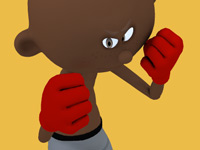
RESOURCES
This article uses material from the Wikipedia articles "Boxing" and "Marquess of Queensberry Rules" which is released under the Creative Commons Attribution-Share-Alike License 3.0.
© Stories Preschool. All Rights Reserved.
